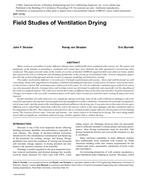Description
Many enclosure assemblies in many different climates have traditionally been ventilated with exterior air. The nature and magnitude of the benefits of providing a ventilated wall system have been debated, but little quantitative research has been conducted. This paper presents some of the results of a series of detailed ASHRAE-supported full-scale field test house studies that explored the role of ventilation and sheathing membranes in the drying of wood-framed walls. Several companion papers describe the technical background and the results of computer modeling and laboratory testing.
The studies involved five different 1.2 m wide and 2.4 m high wood-framed wall systems—three clad with brick and two with vinyl siding. Along with comprehensive boundary conditions (including driving rain), a total of over 20 sensors were used to monitor the moisture content, RH, and temperature within each wall system. Air velocity within the ventilation space of the brick veneer was also measured directly. A unique intra-wall wetting system was developed to uniformly and repeatedly wet the sheathing of the walls in a uniform manner. The walls were wetted three times at different times of the first year and their response-monitored. Changes were made to the size of the ventilation space in all walls, and a second year and three more wetting-drying cycles were imposed.
Results included: all walls allowed a very significant amount of drying, some of the walls exhibited no damage at all at the end of the experiment, drying rates varied significantly during different weather conditions, ventilation increased the drying potential of some walls, and the nature of the sheathing membrane influences the drying rate. It was also shown that solar-driven vapor diffusion acts to redistribute vapor from within the wall to the interior (where it did cause damage) and that ventilation reduces the magnitude of this flow. This reduction of inward drives due to ventilation had a larger effect for the absorptive brick cladding tested. The location of brick vents—both top and bottom—was clearly shown to be beneficial to drying. The vinyl siding profile tested allowed significant ventilation-induced drying, whether applied with or without furring.
Citation: Thermal Performance of Exterior Envelopes of Whole Buildings IX
Product Details
- Published:
- 2004
- Number of Pages:
- 13
- File Size:
- 1 file , 4.7 MB
- Product Code(s):
- D-BldgsIX186




